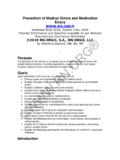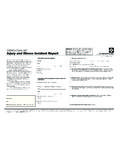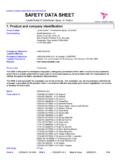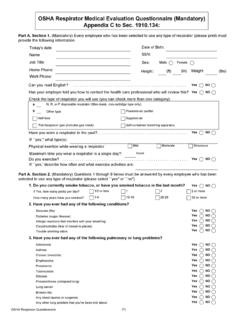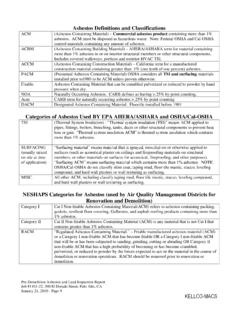Transcription of OSHA Regulations and Bloodborne Pathogens - - …
1 osha Regulations and Bloodborne Pathogens . Reviewed May, 2016, Expires May, 2018. Provider Information and Specifics available on our Website Unauthorized Distribution Prohibited 2016 , , , LLC. By Melissa K Slate, RNC. Objectives By the end of this course, the nurse will be able to: 1. Recognize importance of osha Regulations in the workplace 2. Identify osha Regulations regarding Bloodborne Pathogens 3. Identify Regulations regarding sharps safety and handling Introduction The purpose of this educational activity is to give the nurse a working knowledge of Occupational Safety and Health Administration Standards ( osha ) and to educate and reinforce knowledge regarding Bloodborne pathogen and sharps safety as well as other important osha standards relative to healthcare workers.
2 osha was established by an act of Congress in 1970 with the mission to assure the safety and health of America's workers by setting and enforcing standards;. providing training, outreach, and education; establishing partnerships; and encouraging continual improvement in workplace safety and health" (Shenold, 2008). osha Regulations in healthcare are enforced by a joint effort between osha , Joint Commission on the Accreditation of Healthcare Organizations (JCAHO), and Medicare. All regulatory agencies work together by ensuring compliance with osha standards during surveys. In 2005, there were million job related accidents and illnesses that were non fatal in nature that amount to 117 billion dollars in costs.
3 In 2006, there were a total of 5, 703 employee deaths, although these figures do not account for deaths that were from occupationally acquired illnesses. Three federal agencies comprise osha as a whole: osha , within the Department of Labor; the Occupational Safety and Health Review Commission;. and the National Institute for Occupational Safety and Health (NIOSH), within the Department of Health and Human Services (Shenold, 2008). The duties of osha include writing the standards or Regulations for workplace safety, conducting reviews to assure compliance, and prosecuting violations of standards. The Review Commission is responsible for the mediation of disputes between osha and the employers, and NIOSH is responsible for research into best practices for workplace safety and making recommendations regarding proper procedures and equipment.
4 The need for osha in the healthcare environment came to the forefront with the emergence of the HIV virus and concern for the possibility of health workers acquiring the virus through patient contact. In 1989, osha made recommendations regarding Bloodborne Pathogens and after review and comments by experts in multiple sectors of healthcare the final rule was published in 1991. Bloodborne Pathogens The Bloodborne Pathogens act of 1991 is to limit the exposure of the healthcare worker to blood and body fluids that could potentially cause occupational disease. The standards cover all employees who could reasonably be expected to come into contact with blood or other body fluids during the course of their job activities.
5 Employers are required to implement an Exposure Control Plan than makes Universal Precautions mandatory and treats all blood and body fluids as infectious with the exception of sweat. This plan centralizes hand hygiene and the use of Personal Protective Equipment (PPE) as protection against blood and body fluid infection. PPE includes gowns, gloves, masks, goggles and resuscitation bags. These materials must be available to the employee at no charge. Also part of the standard are measures to prevent needle sticks and blood splashing, and to ensure the appropriate packaging and handling of body fluid specimens and to lable the specimens and waste with biohazardous labeling before shipping or waste removal.
6 The standard also requires methods for the disposal of contaminated sharps and the container used for such disposal. Another rule of the standard allows for the vaccination, within 10 days of employment, of all healthcare workers at no charge, against Hepatitis B if they have occupational exposure to blood. For employees that have an exposure, post-exposure evaluation and followup such as laboratory evaluation, counseling, and prophalaxis are made available to the employee Common Pathogens transmitted by Bloodborne exposure include Hepatitis B, Hepatitis C, and HIV. Hepatitis C Virus (HCV). Hepatitis C can be transmitted to healthcare workers by accidental needle sticks, cuts, or blood splashed onto the conjunctiva.
7 Following percutaneous injury the infection rate is only One thousand health care workers are infected on an annual basis and Hepatitis C is the number one cause of liver transplantation in the United States. Hepatitis C is considered more lethal than Hepatitis B because there is no preventative vaccine for the illness. Hepatitis C can lead to liver failure and liver transplant. Often patients with Hepatitis C have HIV as well and both viruses can be acquired with one exposure of the health care worker. HCV is usually treated with interferon injections, but the medication is expensive, side effects are many, and the disease often returns when the treatment is stopped.
8 It is not recommended that healthcare workers who have an exposure to HCV be treated by prophylaxis with interferon preparations. HIV. The likelihood of HIV infection after percutaneous injury is However, if the patient has severe advanced disease, the needle was used in an artery or vein prior to exposure and the needle is visibly contaminated with blood, then the risk is increased. For healthcare workers who are exposed to HIV, then post-exposure prophylaxis is recommended with HIV specific medications to prevent seroconversion. A. two-drug regimen must be used and continued for at least 4 weeks of therapy.
9 The medications can cause side effects and are often discontinued by the worker due to the side effects, before the 4-week time interval is up (CDC, 2003). Hepatitis B Virus (HBV). Hepatitis B virus is a highly infectious and transmissible virus. Between 6 and 62% of all needle stick exposures result in transmission of the hepatitis B virus. Vaccination of healthcare workers has dramatically reduced the incidence to occupational transmission of hepatitis B, however, not all workers who have the potential for blood exposure have been vaccinated against the virus. If you receive a blood exposure, wash cuts and needle sticks with soap and water.
10 There is no scientific evidence that squeezing the wound or using antiseptics or bleach on the wound will prevent inoculation with bacteria or a virus. If the exposure is to the mouth, nose, or skin flush those areas immediately with water. For splashes to the eye, irrigate the eyes with clean water, saline, or sterile irrigation solution. You should report the exposure to the department that handles occupational events such as employee health, infection control, or occupational health. Prompt reporting is essential, as some measures may need to be taken to prevent infection within the first 24 hours if deemed appropriated to the situation.









